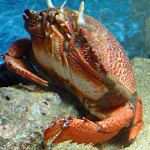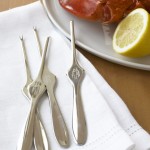
Crab
By Cat, Jan 2016 (Photo, right, from Wikimedia Commons)
- See also: 1. Foods (About) Menu; 2. Using Live Clams & Mussels (Storage, Steaming);
- Includes: 1. Purchasing, storing and cooking crustaceans (humanely); 2. Getting the meat out
My favorite seafoods are mussels, crab and lobster. I also like many preparations of crayfish, but have never cooked them myself. Small shrimp and scallops (bay scallops) are problematic for me because of an allergy; larger varieties usually don’t cause problems, but I don’t eat them often.
Seafood stew such as bouillabaisse or cioppino is my favorite way to prepare crustaceans and shellfish. And I love just simply steaming mussels and baby clams in a flavorful broth.
Prepping shellfish and crustaceans for use in recipes can be daunting, but it is fairly easy, once you know how.
Purchasing, Storing, and Cooking Crustaceans (Humanely)
Crustaceans do not have an internal skeleton, but they do have cartilage and a hard outer shell (exoskeleton) which the moult so they can grow. Their body is in three parts: head, torso and tail; plus legs (which may have claws, and antennae. Like fish, they also have gills that filter the water they intake for the oxygen it contains.
One should always purchase live shellfish and crustaceans, because they tend to spoil rapidly and may not be safe to eat. Also make sure it is still alive, right before preparing to cook it.
If you need to store the live creatures, do so with care; do not leave them wrapped up in butcher paper or in a plastic bag/container, because this does not allow body fluids to drain.
To store safely: use a slotted drainage container over a tray to catch the water, and rinse them occasionally. Live clams & mussels still in the shell should be stored in the refrigerator in a dampened cotton bag or in a bowl covered with a wet cloth.
To cook: The most common – but not exactly humane – way to cook crustaceans is to place them, live and kicking, into a pot of boiling water.
To prepare crustaceans humanely:
- Start by freezing them for around 15 minutes. This will not kill them, but it will numb their nervous systems so they will not feel the pain of the killing method or cooking in boiling water. (8)
- Next, place the numb crustacean back down on a cutting board. Because it is frozen, it will move sluggishly, making the next part of this operation safer and more accurate.
For lobsters: Keep one hand on the tail, and use the other to position a heavy chef’s knife slightly above the middle of the lobster’s torso, with the blade facing towards the head. Use a single sharp movement to chop the lobster in half from mid-torso to head, killing it instantly, and then throw it into a pot of salt water for cooking. (8)
For crayfish: Before cooking, rinse them until draining water is clear; no need to purge them with salt (7). Cannot find instructions on how to kill them humanely, but because they are a close cousin to a lobster, a similar method might work. Or boil them alive only numbing them in the freezer.
For crab: These creatures have a tail, but it is tucked under the body, making it difficult to kill it as you would a lobster. Instead, after freezing, you dull its two nerve centers so it doesn’t feel the boil. See a short YouTube video: Humane dungeness crab kill video (9).
For shrimp: See Fine Cooking (4) and Recipe Tips (11) for details on shelling and deveining shrimp prior to cooking them; however, this doesn’t seem to be very humane, unless you kill them first. Still looking for info on how to kill and cook them humanely.
Precautions when purchasing shrimp (11);
-
- Fresh shrimp should smell clean, refrain from shrimp that smells of ammonia.
- At the fish market, fresh shrimp should be stored in or on ice.
- If you purchase frozen shrimp, avoid shrimp that was peeled and deveined prior to freezing. The practice of cleaning the shrimp before freezing may cause a loss of flavor and texture.
- Be aware of leakage or frozen surface ice on frozen shrimp. These are signs that the shrimp has been defrosted and refrozen and should be avoided.
Prep for cooking (11):
-
- “Refresh” frozen shrimp by soaking in salted water, 1 to 2 tbsp of salt to 1 quart of water.
- The best way to keep shrimp fresh while preparing them is to keep them in ice water. Return the cleaned shrimp to the ice water until you are ready to cook them. Pat the shrimp dry with a paper towel before cooking.
- Leave the shell on while boiling or steaming shrimp. The shell preserves the juices and natural flavors.
Storing tips (11):
-
- Fresh shrimp that has not been cooked is very perishable. Use within two days of purchase to ensure optimal taste.
- Store fresh shrimp that will not be cooked immediately in the coolest area of the refrigerator, preferably on ice and covered with waxed paper. The waxed paper allows air to circulate around the shrimp.
- Cooked shrimp that is stored in the refrigerator should be eaten within 2-3 days.
- Frozen shrimp, if packaged tightly, will last up to six months in most household freezers.
- Shrimp that has been frozen tends to lose texture.
- Once defrosted, shrimp should be kept refrigerated and used within three days.
- Once defrosted, do not refreeze shrimp.
Removing head, shell, legs and tail (optional). NOTE: shrimp purchased at a store or fish market usually have already had the head removed (11):
-
- If head is present, gently pull it off if the recipe calls for the head to be removed.The shell is fairly easy to remove, after the legs have been pulled-off. Or remove both shell and legs at the same time. See Recipe Tips (11) for photos and details
- The tail can also be removed at same time you remove the shell, but pulling it off.
- Et voila! the meat is exposed and ready to cook.
Getting the meat out

Lobster picks
For this task you will need a lobster pick (lobster fork) or a small spoon, and a good knife. Photo, left, from Williams and Sonoma (5).
Crab
Edible meat is found in the claws, legs, body and main shell, and is removed after the crab is cooked. These instructions are from Great British Chefs (1); see also their YouTube video (1).
- Remove cooked crab from the cooking water/broth, and lay it on its back. Twist off the legs and claws and set them aside for now. They can be served intact, or see below for removing the meat.
- Body: With the crab still on its back, and holding firmly on to its shell, push the body section out with your thumbs.
- Pull off the ‘dead man’s fingers’ (their gills) – these are tough and inedible and should be discarded, but are not poisonous per-se; however, they could be contaminated from filtering the water they live in.
- Scoop out the brown meat from the shell and reserve.
- Cut the body section in half, being careful not to disturb the cartilage, as it will be difficult to remove later. Using a small spoon or lobster pick, carefully remove the white meat.
- Legs: Crack open the legs and pull out the meat with a lobster pick.
- Claws: Twist the sections apart, then break the sections with the end of a heavy knife. You don’t want to use so much pressure that you smash the shell into pieces, as you do not want those pieces int he final dish.
- Remove meat with a spoon or lobster pick.
- Finally, pick through the crab to check for any stray shell. You may want to do this a number of times to be completely sure you don’t get a nasty shock when eating the crab!
Crayfish (Crawdads)
This crustacean is a freshwater lobster, but in general are much smaller than their saltwater cousin; they are typically served whole, leaving the task of removing the meat to the diner. These instructions in 5 steps are from The Kitchn blog (2), and are performed after the crayfish are cooked – typically boiled (See Cajun Crawfish (7) for a humorous description of a Cajun crawfish boil).
- Crack off the head: Pick up the crawfish and crack or twist the head right off (and save for later). This will leave you with a few inches of crawfish body and tail.
- Peel off the first three segments of shell: The first three segments of the body are the thickest and toughest, so they are easy to peel off with a few tugs.
- Snap the tail: Press the flipper-part of that little tail upwards, against its natural curl. You should hear a little snap as the cartilage breaks.
- Suck out the meat: Amazingly, with those few steps, all the meat in the body of the crawfish has loosened from the shell. Suck on the body and the meat comes right out.
- Suck the head: That sounds pretty gross (for several reasons), but the head has some delicious crawfish-y juices that you seriously don’t want to miss.”
Lobster
See Fine Cooking on Getting to the meat of a lobster (3), including meat in its claws, legs. See also 3-minute YouTube video (6):
Shrimp
Unlike the other types of crustaceans, the meat is exposed before cooking, by removing the head, shell, legs and tail; see above.
References:
- Great British Chefs, on How to remove meat from a crab: greatbritishchefs.com/how-to-cook/how-to-remove-meat-from-a-crab; also 2-minute YouTube video youtube.com/watch?v=gopHYbida08
- The Kitchn: Crack and Peel: an easy way to eat crawfish thekitchn.com/crack-and-peel-an-easy-way-to-149422
- Fine Cooking on Getting to the meat of a lobster: finecooking.com/articles/getting-meat-lobster.aspx
- Fine Cooking on shelling and deveining shrimp (finecooking.com/articles/how-to-peel-devein-shrimp.aspx)
- Williams and Sonoma photo, williams-sonoma.com
- Three Son’s Lobster video on How to pick lobster meat, youtube.com/watch?v=oTvlweJnpZw
- Cajun Crawfish, on boiling crayfish (crawdads): cajuncrawfish.com/how-to-boil-crawfish.htm
- Wisegeek on humane way to kill and cook lobster, wisegeek.com/is-it-cruel-to-cook-shellfish-and-crustaceans-alive.htm
- Humane dungeness crab kill video: youtube.com/watch?v=A4XS11RXyHM
- Cajun Crawfish, on prepping crayfish (crawdads): cajuncrawfish.com/how-to-boil-crawfish.htm
- Recipe tips: How to prepare and devein shrimp, http://www.recipetips.com/kitchen-tips/t–1239/how-to-prepare-and-devein-shrimp.asp
